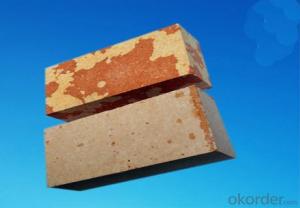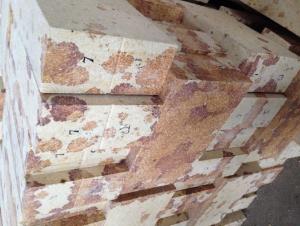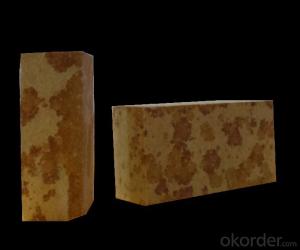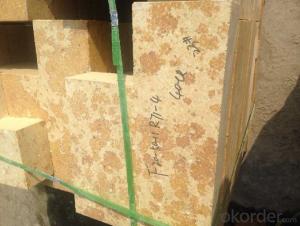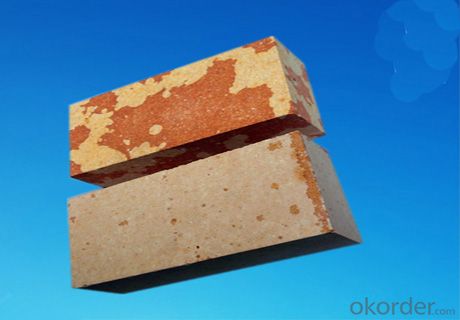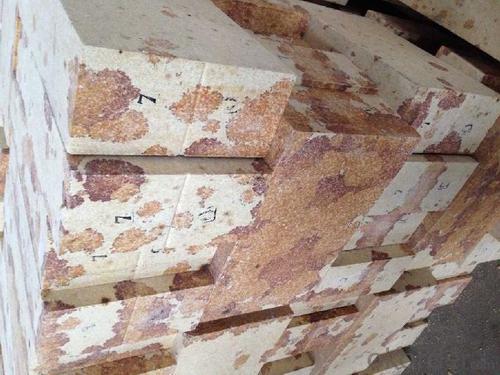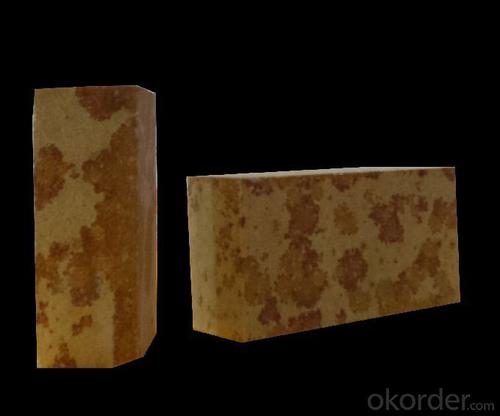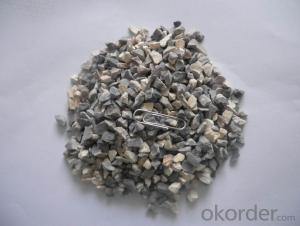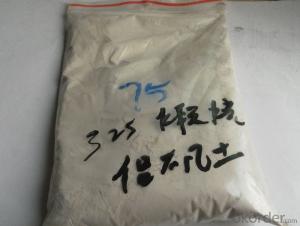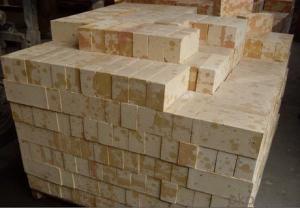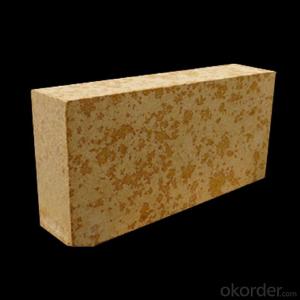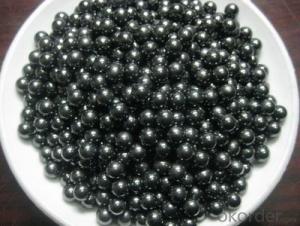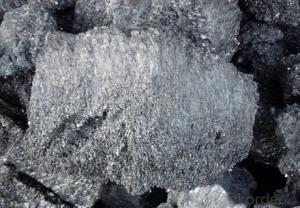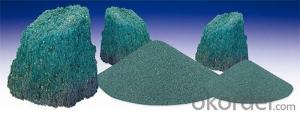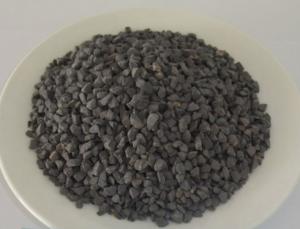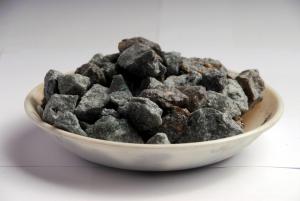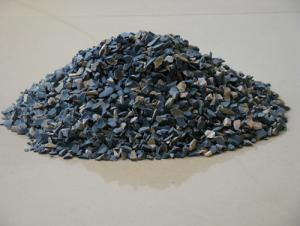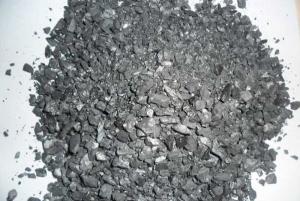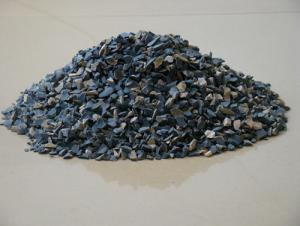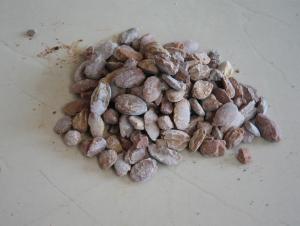Raw Materials for Refractory Silicon Bricks Used in Glass Kiln
- Loading Port:
- Tianjin
- Payment Terms:
- TT OR LC
- Min Order Qty:
- 20 m.t.
- Supply Capability:
- 5000 m.t./month
OKorder Service Pledge
OKorder Financial Service
You Might Also Like
General Information:
CMAX brand Silica bricks are made from high quality quartz tail sand, lime and mineralizing agent through the process of crashing, screening, mixing, pressing, drying and sintering.
Features of Refractory silica bricks for Glass Kiln:
1. high volume density of 2.34 g/cm3
2. high SiO2 content of 96%
3. low iron content of 0.8%
4. low melting point of 5%
Applications of Refractory silica bricks for Glass Kiln:
Because of the high temperature resistant performance significantly, long service life characteristics (as long as more than eight years) of refractory silica brick for Glass Kiln, it can significantly improve the quality of glass, so the refractory silica bricks are widely used in all kinds of glass furnace melting department, regenerator and other important parts.
Physical and chemical index of refractory silica bricks for glass kiln:
Item Brand | CMAX-96A | CMAX-96B | ||
SiO2 % ≥ | 96 | 96 | ||
Al2O3+2(K2O+Na2O) % ≤ | 0.5 | |||
Fe2O3 % ≤ | 0.8 | 1 | ||
Refractoriness °C ≥ | 1710 | 1710.0 | ||
0.2MPa Refractoriness under load °C ≥ | 1680 | 1670 | ||
Apparent porosity % ≤ | Brick with weight no less than 20kg | 20 | 20 | |
rick with weight less than 20kg | 22 | 22 | ||
CS MPa ≥ | 35 | 35 | ||
Bulk desity g/cm3 ≤ | 2.34 | 2.34 | ||
Starndard Size:
230*114*64mm
230*114*76mm
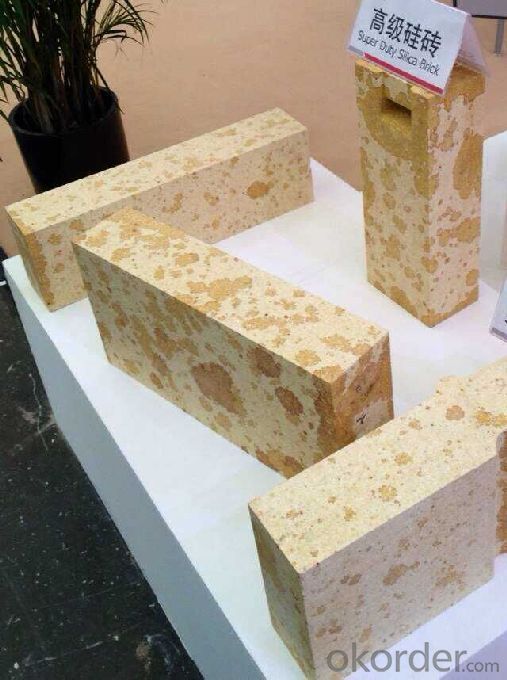
- Q: Can someone professionally introduce the classifications of refractories?
- It can be divided into two categories of ordinary and special refractory. Ordinary refractories can be devided into acidic, neutral and alkalinee refractories according to chemical properties. Special refractory can be devided into high temperature oxide, refractory compounds and high-temperature composite materials according to the compositions. Furthermore, it canbe devided into ordinary refractory products (1580 ~ 1770 ℃), advanced refractory products (1770 ~ 2000 ℃) and super refractory products (above 2000 ℃) according to the strength of refractoriness. It can be divided into bulks (standard brick, special-shaped brick, etc.), special shape (crucible, sagger, pipe, etc.), fibrous (aluminum silicate, zirconia and boron carbide, etc.) and Indefinite shape (refractory clay, castableand ramming mass, etc.) according to the shapes of products. According to the sintering process, it can be divided into sintered products, cast products, melting jetting products.
- Q: The mechanism and function of antioxidants in carbon containing composite refractories are briefly described.
- With the advantages of carbon refractories especially excellent slag resistance and high heat stability, but graphite under high temperature oxidation, in order to improve the oxidation resistance of carbon composite refractory materials, often adding a small amount of antioxidants, to improve the oxidation resistance of carbon composite refractories. Antioxidant additives commonly used in metal powder, silicon powder, magnesium powder, silicon carbide powder and so on.
- Q: What's the refractory material?
- Frequently used refractory material: AZS brick, corundum brick, direct-bonded?magnesia-chrome?bricks, carborundum brick, silicon nitride bonded silicon carbide brick, nonoxide refractories like nitride, silicide, sulfide, boride and carbide, and oxide refractories like calcium oxide, chromium hemitrioxide, alumina, magnesium oxide and beryllia. In general, the refractory material include the above. For more information, you can ask for specific advice.
- Q: What are the new refractories? What are the features? How about their application and development?
- In metallurgy, in what position should it be used, in order to make the best. Answers are as following. In iron, steelmaking or converter. When questioning, pay attention to the ways. Answers: Try to use synthetic refractory materials.
- Q: What are the raw materials of refractory?
- Of course, different types have different raw materials: Magnesite (the electric?smelting: alkaline refractory, magnesia-carbon bricks, alkaline, high-purity) + crystalline flake graphite + phenolic resin + additive (silicon powder, aluminite powder, silicon carbide powder, or high-temperature asphalt,etc.) , acidic refractory: The neutral is not easy to answer. such as. You can check out the classification, such as
- Q: How to choose construction external wall thermal insulation and fireproofing materials?
- The width of fireproof partition shuld be greater than 30CM, and the thickness should be the same as total thickness of thermal insulation materials. Fire barrier zone thermal insulation board and base wall should be stuck in whole area. Fire Barrier zone thermal insulation board should be stuck with the assistance of anchor bolt which must press the mesh of the bottom layer. Fire Barrier zone should be set above the door and window, with a distance of less than 50cm between the lower edge of fire barrier zone and the upper edge of window.
- Q: Who knows the new fireproof and thermal inuslation matertial?
- New fire insulation material, having a foam material body, with the following characters: Outside of the foam material body bonds the aluminium foil composite glass fiber cloth, which is bonded by the aluminium foil and glass fiber cloth through fireproof glue. The utility model has the following advantages: Bonding the aluminum foil composite glass fiber cloth to the outer surface of the foam insulation material, will strengthen thermal insulation index, also will prevent the burning of the foamed material, thus ensuring the fireproofing safety of the foam insulation material.
- Q: What is the fireproofing requirements of external wall thermal insulation materials?
- According to the "building external wall insulation fire barrier zone technical regulations" to be published: it is not less than the level B2. But before the procedure was published, it should be strictly implemented the document, level A is the best, I hope to help you, hope to adopt
- Q: What are the specifications of refractory kilns ?
- There several points need to be noted ① selection of body material. The refractory lining of the front kilneye turns gelid and hot rapidly and frequently, so the temperature is in the range of 800 ℃ ~ 1250 ℃, allowing it to withstand wear of the cement clinker and corrosion of the cement base. The body material of castable refractory must be chosen according to its service conditions, in order to ensure that it is cheap and easy to use. ② the selection of admixture. Shapeless refractory materials are typical in-situ reaction refractories. Therefore choosing admixtures is very important and must ensure workability, baking performance, and excellent material properties. Admixture for Kiln refractory castable includes dispersants, accelerators, plasticizers, sintering agent, bulking agent and antidetonant. Materials of sintering agent are animate clay, zirconite, titanium dioxide and Peng compounds. Such substances produce a certain amount of mullite crystals, zircon phase, titanium aluminate crystal and inconsistent melting compounds (2Al2O3 ? B2O3), etc. under the operating temperature and in situ reaction. They are accompanied by volume expansion and microcracks, enabling it to compensate for the sintering shrinkage, so that the casting material can have sintering strength, corrosion resistance and good thermal shock resistance. In summary, the refractory castable material for the rotary kiln shall be determined in accordance with its service conditions. It is recommended that clients should also communicate with technical personnels and sales staff about some facts of the rotary kiln when buying it, so that they can get the satisfying rotary kiln.
- Q: Who knows about the B-level fireproof insulation materials?
- Organics, extruded sheet, polyphenyl board and phenolic resin. The fireproof?performance of sea capacity module (fireproof and thermal insulation material) is B1-level with the heat conductivity coefficient of only 0.028w / m · k. It is a good choice. A-level: Rock wool, glass wool, silicate, aluminum silicate, calcium silicate, phenolic aldehyde, and foam glass. B-level: Rubber and plastic, extrusion molding, polyphenyl, PEF.
Send your message to us
Raw Materials for Refractory Silicon Bricks Used in Glass Kiln
- Loading Port:
- Tianjin
- Payment Terms:
- TT OR LC
- Min Order Qty:
- 20 m.t.
- Supply Capability:
- 5000 m.t./month
OKorder Service Pledge
OKorder Financial Service
Similar products
Hot products
Hot Searches
Related keywords
